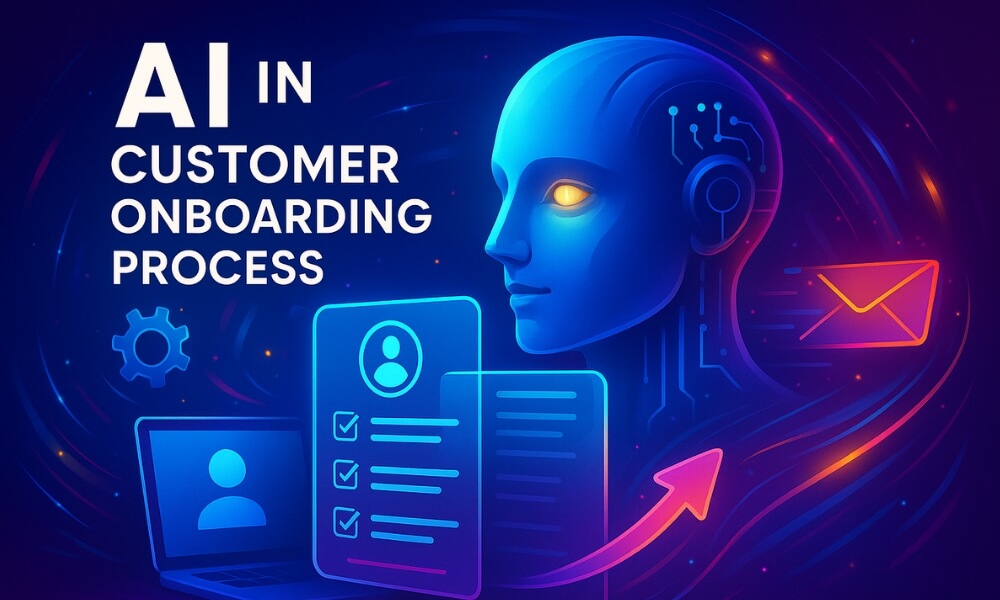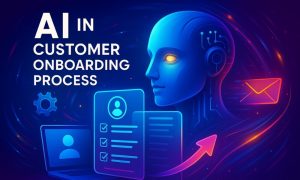Customer onboarding is one of the most critical moments in the entire customer lifecycle. It’s the phase where expectations are either validated or lost, and it often determines whether a new user becomes an engaged customer or quietly disappears.
Yet for many companies, onboarding is still static, generic, and disconnected from how users actually behave.
Most onboarding systems treat every customer the same. They rely on linear checklists, scripted emails, or outdated walkthroughs that don’t adapt to user needs or context. As a result, users get overwhelmed, support tickets pile up, and product adoption stalls before it ever really begins.
This is where artificial intelligence changes the equation.
AI brings a layer of intelligence, automation, and personalization to onboarding that traditional systems simply can’t match. It allows businesses to analyze real-time behavior, identify friction points early, deliver contextual support instantly, and guide each user through a tailored onboarding experience automatically.
In this guide, we’ll explore how AI transforms the onboarding process into a smart, dynamic, and scalable system. You’ll learn where traditional onboarding falls short, how AI solves those gaps, and the practical strategies to implement AI across your onboarding flow whether you’re a SaaS company, fintech platform, or customer success-driven business.
Because in today’s product landscape, the first impression isn’t just important it’s everything. And AI helps you get it right, at scale.
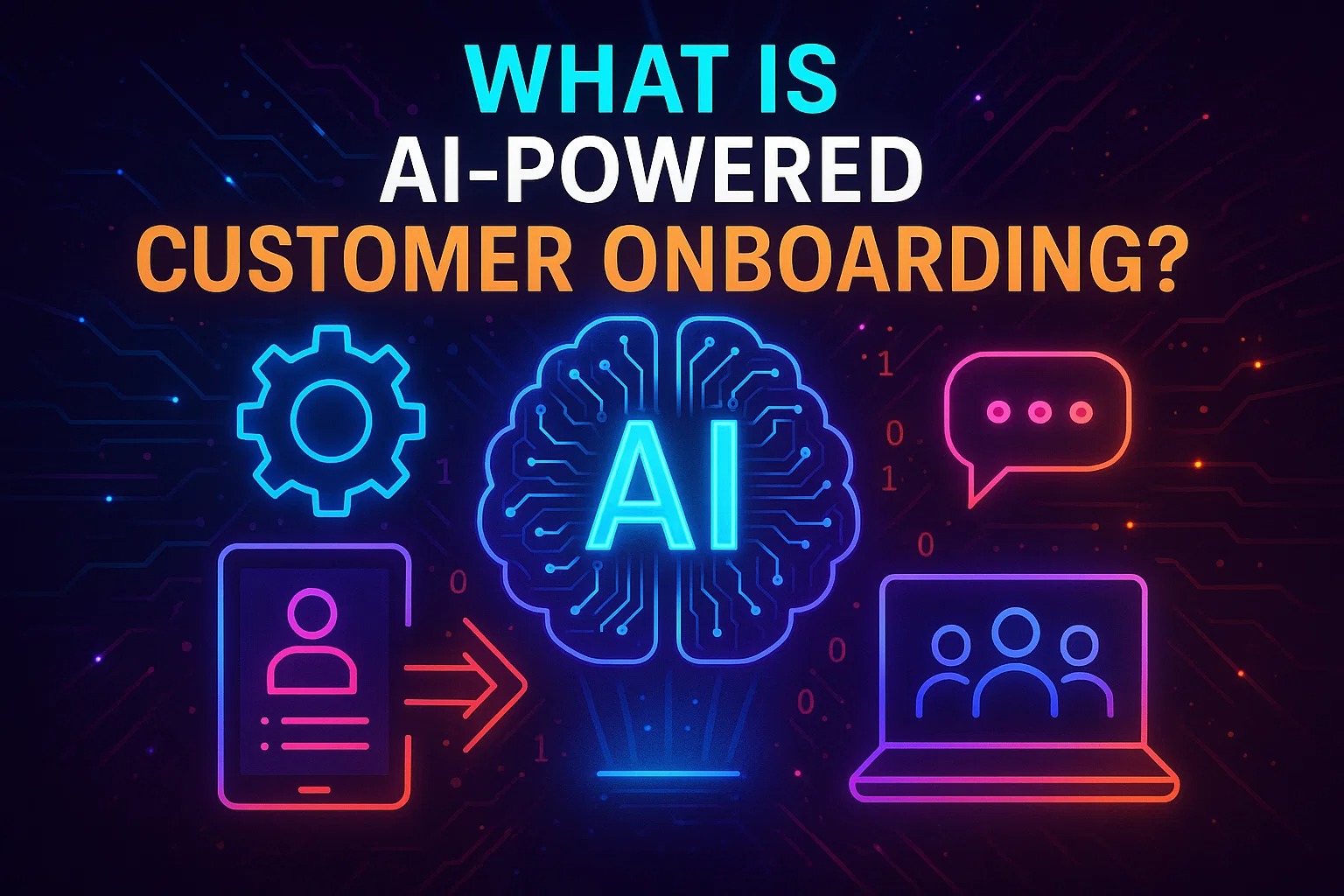
What is AI-Powered Customer Onboarding?
AI-powered customer onboarding refers to the use of artificial intelligence to guide new users through a product or service experience in a dynamic, personalized, and data-driven manner. Unlike traditional onboarding flows, which are static and identical for every user, AI adapts in real time based on individual behavior, preferences, and engagement patterns.
At its core, AI onboarding is about turning what was once a one-size-fits-all experience into a tailored journey for every customer—without adding manual effort.
Here’s how it works in practice:
- Instead of sending the same welcome email to every user, AI selects messaging based on the user’s goals or role.
- Instead of showing all users the same in-app walkthrough, AI guides each one based on the features they’ve engaged with—or skipped.
- Instead of waiting for a support ticket, AI-powered chatbots offer instant answers to common questions based on natural language input.
- Instead of guessing who’s struggling, AI predicts drop-off points before they happen—so your team can act before it’s too late.
Why Traditional Onboarding Falls Short
Most companies understand that onboarding is critical. But the way they deliver it hasn’t changed in years—and it’s costing them users, trust, and long-term growth.
Traditional onboarding typically relies on rigid flows: pre-written emails, one-size-fits-all product tours, and static checklists. These might work for the average user—but in today’s market, there’s no such thing as “average.” Every customer brings different goals, roles, and levels of experience. When onboarding fails to account for that, engagement suffers.
Here’s where traditional approaches break down:
1. One-Size-Fits-All Journeys
A new user signing up as a marketing manager doesn’t need the same onboarding experience as a technical admin. But static onboarding treats them the same—leading to confusion, skipped steps, or early drop-off.
2. No Real-Time Adaptation
Traditional systems don’t adapt based on how users behave inside the product. Whether someone is stuck, thriving, or exploring unexpected features, the onboarding flow doesn’t change. It runs on rails—and users feel it.
3. Delayed or Manual Support
When a new user hits a roadblock, they often need to wait for help or dig through documentation. This delay increases frustration and lowers perceived product value at the worst possible time—during first use.
4. No Early Warning System
If someone signs up but never completes the first task, most traditional systems won’t notice until it’s too late. Without proactive detection, teams miss the chance to intervene and turn disengagement into activation.
5. Disconnected from Success Metrics
Traditional onboarding often stops at the welcome email or product tour. It doesn’t connect to actual success milestones like first value delivered, core feature adoption, or early retention signals.
6. Lacks Scalability
For growing teams, scaling onboarding with human-led calls or custom journeys quickly becomes impossible. Traditional methods strain your CS team or force you to compromise quality for volume.
How AI Improves the Customer Onboarding Process
AI doesn’t just automate onboarding — it makes it smarter, faster, and far more effective. By turning passive workflows into intelligent systems, AI enables companies to create onboarding journeys that adapt in real time, respond to user behavior, and drive long-term engagement from day one.
Here’s how AI transforms each layer of onboarding:
1. Personalized Onboarding Paths
AI analyzes user data — such as role, goals, behavior, and industry — to build onboarding flows tailored to each user’s context.
Instead of: Every user getting the same generic walkthrough
AI enables: Dynamic guidance based on what the user actually needs to see
This personalization reduces overwhelm, accelerates time-to-value, and improves activation rates.
2. Predictive Behavior Modeling
AI systems detect patterns that indicate whether a user is moving toward success or heading toward drop-off.
Instead of: Waiting until users disengage
AI enables: Early intervention based on usage gaps, skipped actions, or inconsistent engagement
This allows your team to proactively step in before churn risk becomes reality.
3. AI-Powered Chatbots and Virtual Assistants
Modern AI-driven chatbots provide instant, contextual support based on where users are in their journey.
Instead of: Forcing users to search documentation or wait for support
AI enables: In-product help that understands intent and responds like a human — 24/7
This reduces friction and support ticket volume while improving user confidence.
4. Automated Nudges and Progress Tracking
AI monitors onboarding progress and sends smart reminders to help users complete key actions.
Instead of: Static email sequences or manual follow-ups
AI enables: Trigger-based nudges based on behavior (e.g., “Looks like you haven’t set up X yet — need help?”)
Timely prompts keep users moving forward without feeling pressured.
5. Natural Language Understanding
AI with NLP (natural language processing) interprets user questions and commands in human language.
Instead of: Keyword-based search or rigid forms
AI enables: A smoother experience where users can ask, “How do I invite my team?” and get an instant, relevant response
This boosts user satisfaction and shortens learning curves.
6. Real-Time Segmentation and Adaptive Journeys
As AI gathers data, it continuously updates user segments and tailors the next steps accordingly.
Instead of: Static onboarding tracks
AI enables: Journeys that evolve based on live input — showing different content, tips, or offers based on engagement and persona
The result is onboarding that feels like it was built for each user — because, in effect, it is.
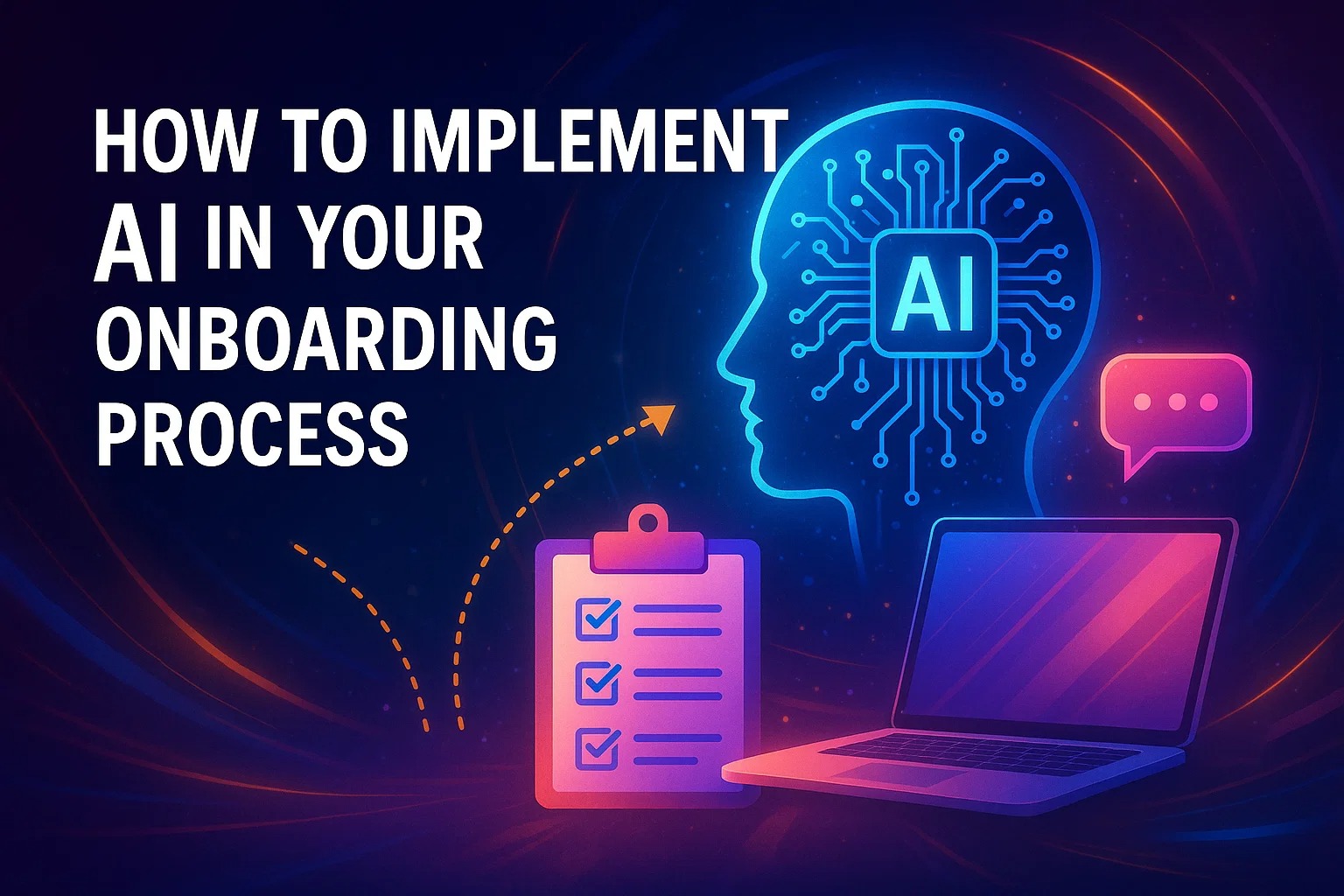
How to Implement AI in Your Onboarding Process
Adding AI to your onboarding process isn’t a plug-and-play upgrade — it’s a layered shift. To be effective, it needs the right data, clear goals, and strategic integration across your onboarding stack.
This step-by-step guide helps you implement AI in a way that’s scalable, measurable, and aligned with actual user needs.
1. Audit Your Existing Onboarding Flow
Start by mapping your current onboarding process end to end. Look at every touchpoint — welcome emails, in-app tutorials, support handoffs, and follow-ups.
Ask:
- Where do users typically drop off?
- What steps cause confusion or support tickets?
- Where does onboarding feel repetitive or generic?
You need to know what’s broken before you automate or optimize.
2. Define Your Key Onboarding Metrics
AI is only effective when tied to measurable goals. Determine what success looks like in your onboarding flow.
Common KPIs:
- Time-to-value (TTV)
- Activation rate
- Day 1 and Day 7 retention
- Completion of onboarding milestones
- Support ticket volume during onboarding
Your AI systems should be aligned to improve these metrics, not just add new functionality.
3. Identify High-Impact Use Cases for AI
Not every part of onboarding needs AI. Focus first on high-friction areas where AI can make a clear difference.
Examples:
- Adding a GPT-powered chatbot to reduce support load
- Creating adaptive walkthroughs based on user role
- Using predictive modeling to flag at-risk users
- Sending AI-triggered nudges when users stall
Start with one or two high-value use cases and scale from there.
4. Choose the Right Tools and Integration Points
Once use cases are identified, select tools that fit your tech stack. Prioritize tools that:
- Integrate with your CRM and product analytics
- Support real-time data flow
- Allow for behavioral targeting and AI logic
- Offer transparency and control
If you’re building in-house, consider using an AI engine (like OpenAI) with behavior observers and trigger logic.
5. Train Your AI Systems with the Right Data
AI only performs as well as the data it learns from. Ensure your models or platforms have access to:
- Product usage events
- Support history
- Customer attributes (e.g., role, plan, industry)
- Success milestones and activation patterns
For chatbots, train on your onboarding documentation, FAQs, and real user conversations to improve accuracy and tone.
6. Launch with a Controlled Rollou
Don’t implement AI across all users on day one. Start with a specific segment (e.g., new users on a certain plan or in a single region). Monitor how they interact with the AI-powered flow and gather feedback.
This gives you:
- Baseline comparison against your old process
- Faster identification of bugs or unexpected behavior
- Insights to refine before full rollout
7. Measure, Learn, and Optimize Continuously
After launch, monitor your key metrics closely. Compare AI-augmented onboarding flows to legacy performance.
Track:
- Engagement with AI features (chat, nudges, guides)
- Impact on activation, retention, and support load
- Qualitative feedback from users and CS teams
Use these insights to improve targeting, messaging, and logic over time. AI onboarding isn’t a one-time project — it’s an evolving system.
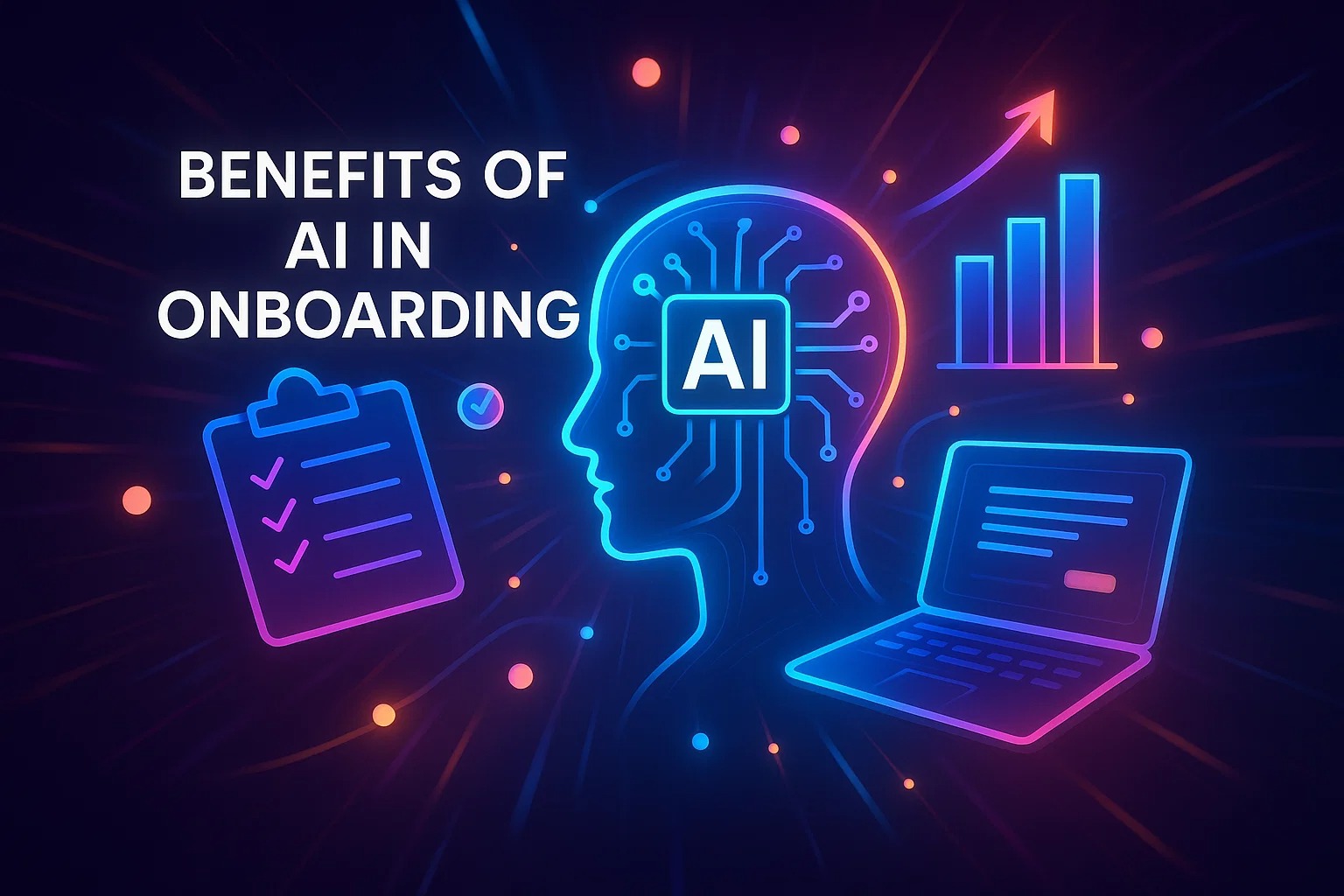
Benefits of AI in Onboarding
Adding AI to your onboarding process isn’t just a tech upgrade — it’s a business shift. Done right, AI drives better outcomes at every level: from user experience to internal efficiency to long-term revenue impact.
Here are the most critical benefits companies unlock when they apply AI to onboarding:
1. Faster Time-to-Value
Every second between signup and success increases the risk of drop-off. AI accelerates that path by showing users only what’s relevant, eliminating unnecessary steps, and proactively guiding them toward their goals.
Result: Users reach their “aha” moment faster, which improves activation and satisfaction rates.
2. Higher Product Adoptio
When onboarding is adaptive, users explore more of the product — not just what’s shown in a linear tutorial. AI helps expose the right features at the right time, making the experience feel natural instead of forced.
Result: Better feature adoption and deeper usage from day one.
3. Reduced Support Volume
AI handles routine support needs instantly — via smart chatbots, contextual help, and automated walkthroughs. This reduces the volume of common onboarding questions that typically clog up support queues.
Result: Your support team can focus on complex, high-value interactions instead of repetitive issues.
4. Early Churn Detection and Prevention
AI can detect warning signs during onboarding — like skipped steps, inactivity, or repeated errors — and trigger alerts or interventions before a user disengages completely.
Result: You don’t just react to churn. You prevent it while the user is still within reach.
5. Scalable Personalization
Traditionally, personalized onboarding only scales with more human effort. AI changes that. It gives every user a personalized journey, regardless of how many people sign up or how lean your team is.
Result: High-quality onboarding at scale — without compromising experience or hiring more people.
6. Continuous Optimization
AI doesn’t stop learning. With every interaction, it gathers data, identifies patterns, and suggests improvements. This allows companies to test and refine onboarding flows based on actual outcomes, not assumptions.
Result: A system that gets smarter — and more effective — over time.
7. Stronger First Impression
The onboarding experience shapes how new users perceive your brand. When that experience is smooth, responsive, and tailored, it creates trust from day one.
Result: Higher retention, stronger engagement, and better word-of-mouth from the very beginning.
Mistakes to Avoid When Using AI in Onboarding
AI can turn onboarding into a scalable, intelligent, and user-centric experience. But if used without care, it can also lead to confusion, misalignment, or even churn. The key isn’t just what you build — it’s what you avoid.
Here are the most common mistakes teams make when introducing AI into onboarding, and how to prevent them.
1. Over-Automation Without Human Backu
AI is powerful, but it’s not a replacement for human support — especially during complex or emotional moments in the onboarding journey.
The risk:
Users get stuck or misunderstood by bots and drop off due to frustration.
What to do instead:
Always offer a clear, easy path to human assistance. Design your AI to handle routine queries and escalate edge cases quickly.
2. Ignoring Context in Personalization
Personalization without proper context feels off — like being recommended a feature you’ve already used or receiving help that doesn’t apply to your role.
The risk:
AI suggestions become noise instead of value, hurting trust.
What to do instead:
Train your AI on segmented data — role, plan, prior behavior — and ensure onboarding logic respects user context at every step.
3. Treating AI Like a One-Time Setu
AI systems aren’t “set and forget.” If they don’t evolve, they get outdated — fast.
The risk:
Out-of-date logic, irrelevant nudges, and missed opportunities to optimize.
What to do instead:
Continuously review your AI workflows. Use feedback, analytics, and behavior trends to retrain and refine regularly.
4. Focusing on Automation Instead of Outcomes
Too many teams implement AI features because they sound impressive — not because they drive onboarding success.
The risk:
Effort spent on tools that look smart but don’t move metrics like activation or retention.
What to do instead:
Tie every AI decision to a measurable outcome: reduced support volume, faster time-to-value, improved product adoption. If it doesn’t improve something real, rethink it.
5. Using Generic, Pre-Trained AI With No Product-Specific Knowledge
Out-of-the-box chatbots or assistants won’t understand your product unless they’re trained with your specific onboarding flows and user language.
The risk:
Misleading answers, incomplete help, or low engagement with AI tools.
What to do instead:
Feed your AI assistant with actual onboarding guides, product walkthroughs, and past support transcripts. Customize tone, language, and logic.
6. Failing to Communicate That AI is in Use
Users appreciate transparency. When it’s not clear they’re interacting with AI, they may feel misled or frustrated by unexpected responses.
The risk:
Loss of trust — especially if the AI misses the mark.
What to do instead:
Clearly label AI-powered features. Set expectations up front (“This is an AI assistant trained on our product guide — here’s what it can do”). Honesty builds confidence.
Final Thoughts
Customer onboarding isn’t just a step in the journey — it’s the moment that defines whether users stay, succeed, or silently walk away. And while most businesses understand its importance, very few are truly optimizing it for how modern users behave, think, or expect to be guided.
That’s where AI makes the difference.
AI in onboarding isn’t about replacing people or automating for the sake of scale. It’s about building an intelligent system that learns from your users, adapts in real time, and delivers a smarter, more human-like experience — one that drives activation, reduces churn, and supports long-term growth.
Author
Shirikant is a proven customer success leader who combines sharp business insight with practical experience to improve retention and drive revenue. As the founder of Statwide, he designs customer-first business strategies that guide companies to turn users into loyal and long-term partners. His approaches are built on real results: stronger relationships, higher customer value, and lasting growth.

